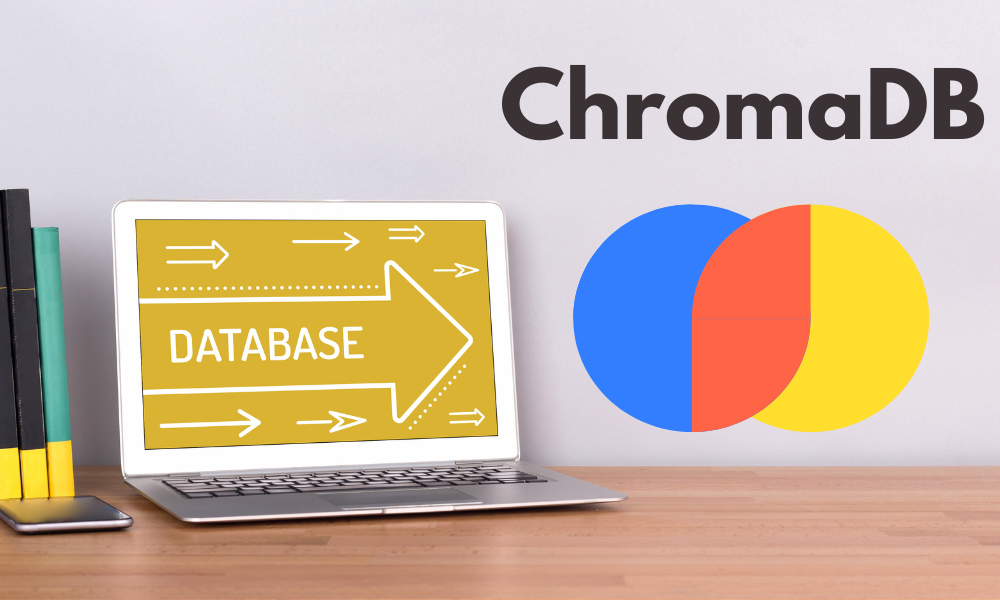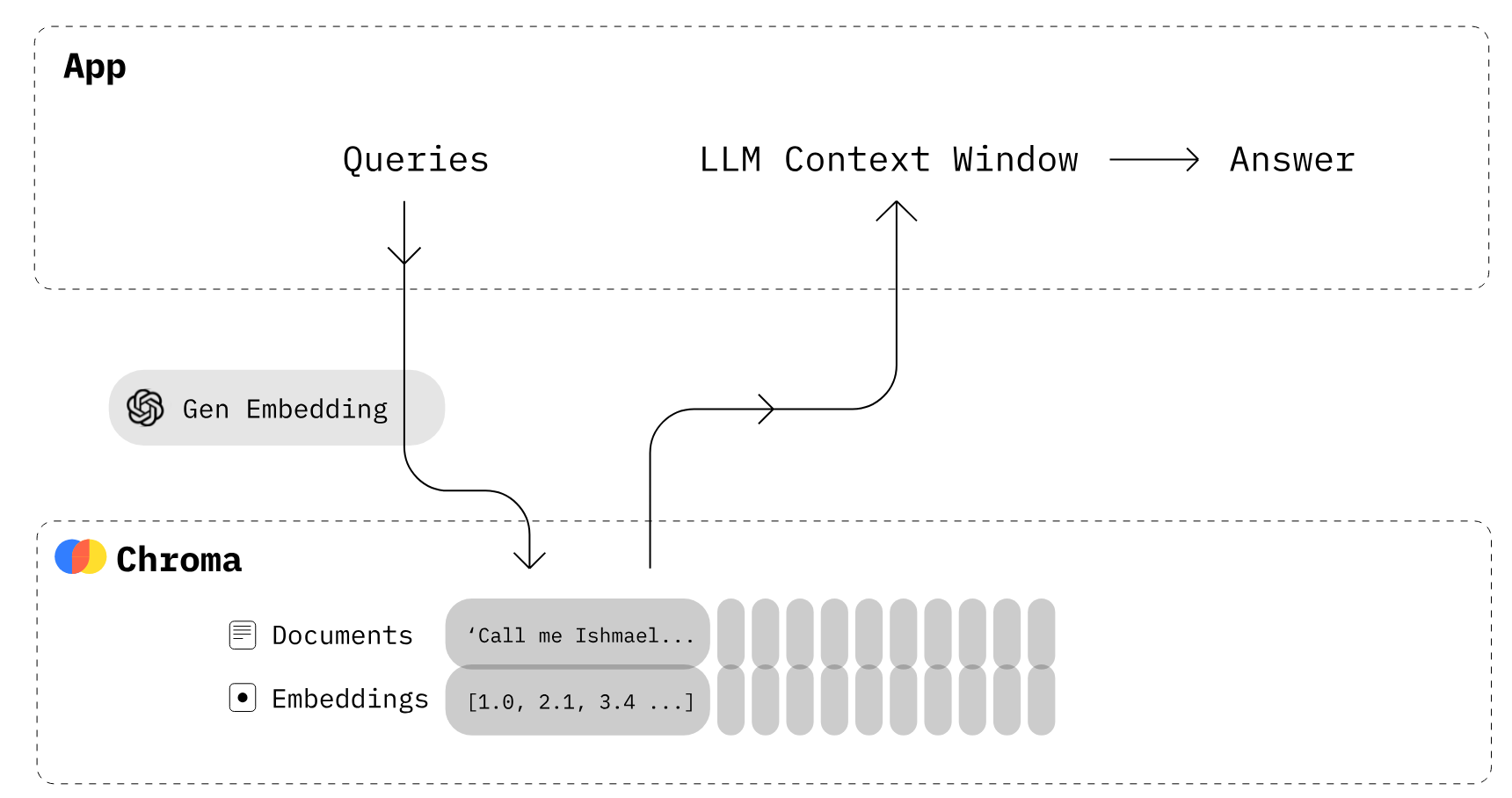Track
With the rise of large language models (LLMs) and their applications, we have seen an increase in the popularity of integration tools, LLMOps frameworks, and vector databases. This is because working with LLMs requires a different approach than working with traditional machine learning models.
One of the core enabling technologies for LLMs is vector embeddings. While computers cannot directly understand text, embeddings represent text numerically. All user-provided text is converted to embeddings, which are used to generate responses.
Converting text into embedding is a time-consuming process. To avoid that, we have vector databases explicitly designed for efficient storage and retrieval of vector embeddings.
In this tutorial, we will learn about vector stores and Chroma DB, an open-source database for storing and managing embeddings. We will also learn how to add and remove documents, perform similarity searches, and convert our text into embeddings.

Image by author
What Are Vector Stores?
Vector stores are databases explicitly designed for efficiently storing and retrieving vector embeddings. They are needed because traditional databases like SQL are not optimized for storing and querying large vector data.
Embeddings represent data (usually unstructured data like text) in numerical vector formats within a high-dimensional space. Traditional relational databases are not well-suited to storing and searching these vector representations.
Vector stores can index and quickly search for similar vectors using similarity algorithms, which allows applications to find related vectors given a target vector query.
For example, in the case of a personalized chatbot, the user inputs a prompt for the generative AI model. Using a similarity search algorithm, the model searches for similar text within a collection of documents. The resulting information is then used to generate a highly personalized and accurate response. This retrieval of information is made possible through embedding and vector indexing within vector stores.
What is Chroma DB?
Chroma DB is an open-source vector store used for storing and retrieving vector embeddings. Its main use is to save embeddings along with metadata to be used later by large language models. Additionally, it can also be used for semantic search engines over text data.
Chroma DB features
- Simple and powerful:
- Install with a simple command:
pip install chromadb. - Quick start with Python SDK, allowing for seamless integration and fast setup.
- Install with a simple command:
- Full-featured:
- Comprehensive retrieval features: Includes vector search, full-text search, document storage, metadata filtering, and multi-modal retrieval.
- Highly scalable: Supports different storage backends like DuckDB for local use or ClickHouse for scaling larger applications.
- Multi-language support:
- Offers SDKs for popular programming languages, including Python, JavaScript/TypeScript, Ruby, PHP, and Java.
- Integrated:
- Native integration with embedding models from HuggingFace, OpenAI, Google, and more.
- Compatible with Langchain and LlamaIndex, with more tool integrations coming soon.
- Open source:
- Licensed under Apache 2.0.
- Speed and simplicity:
- Focuses on simplicity and speed, designed to make analysis and retrieval efficient while being intuitive to use.
Chroma DB offers a self-hosted server option. If you need a managed vector database platform, check out Pinecone and the Pinecone Guide for Mastering Vector Databases.

Image from Chroma
How does Chroma DB work?
- First, you have to create a collection similar to the tables in the relations database. By default, Chroma converts the text into the embeddings using
all-MiniLM-L6-v2, but you can modify the collection to use another embedding model. - Add text documents with metadata and a unique ID to the newly created collection. When your collection receives the text, it automatically converts it into embedding.
- Query the collection by text or embedding to receive similar documents. You can also filter out results based on metadata.
Getting Started With Chroma DB
In this section, we will create a vector database, add collections, add text to the collection, and perform a search query.
First, we will install chromadb for the vector database and openai for a better embedding model. Make sure you have set up the OpenAI API key.
Note: Chroma requires SQLite version 3.35 or higher. If you experience problems, either upgrade to Python 3.11 or install an older version of chromadb.
!pip install chromadb openai You can create an in-memory database for testing by creating a Chroma client without settings.
In our case, we will create a persistent database that will be stored in the db/ directory and use DuckDB on the backend.
import chromadb
from chromadb.config import Settings
client = chromadb.Client(Settings(chroma_db_impl="duckdb+parquet",
persist_directory="db/"
))After that, we will create a collection object using the client. It is similar to creating a table in a traditional database.
collection = client.create_collection(name="Students")To add text to our collection, we will generate random text about a student, club, and university. You can generate random text using ChatGPT.
student_info = """
Alexandra Thompson, a 19-year-old computer science sophomore with a 3.7 GPA,
is a member of the programming and chess clubs who enjoys pizza, swimming, and hiking
in her free time in hopes of working at a tech company after graduating from the University of Washington.
"""
club_info = """
The university chess club provides an outlet for students to come together and enjoy playing
the classic strategy game of chess. Members of all skill levels are welcome, from beginners learning
the rules to experienced tournament players. The club typically meets a few times per week to play casual games,
participate in tournaments, analyze famous chess matches, and improve members' skills.
"""
university_info = """
The University of Washington, founded in 1861 in Seattle, is a public research university
with over 45,000 students across three campuses in Seattle, Tacoma, and Bothell.
As the flagship institution of the six public universities in Washington state,
UW encompasses over 500 buildings and 20 million square feet of space,
including one of the largest library systems in the world.
"""Now, we will use the add() function to add text data with metadata and unique IDs. After that, Chroma will automatically download the all-MiniLM-L6-v2 model to convert the text into embeddings and store it in the "Students" collection.
collection.add(
documents = [student_info, club_info, university_info],
metadatas = [{"source": "student info"},{"source": "club info"},{'source':'university info'}],
ids = ["id1", "id2", "id3"]
)To run a similarity search, you can use the query() function and ask questions in natural language. It will convert the query into embedding and use similarity algorithms to generate similar results. In our case, it is returning two similar results.
results = collection.query(
query_texts=["What is the student name?"],
n_results=2
)
results
Embeddings
You can use any high-performing embedding model from the embedding list. You can even create your custom embedding functions.
In this section, we will use the line OpenAI embedding model called “text-embedding-ada-002” to convert text into embedding.
After creating the OpenAI embedding function, you can add the list of text documents to generate embeddings.
Discover how to use the OpenAI API for Text Embeddings and create text classifiers, information retrieval systems, and semantic similarity detectors.
from chromadb.utils import embedding_functions
openai_ef = embedding_functions.OpenAIEmbeddingFunction(
model_name="text-embedding-ada-002"
)
students_embeddings = openai_ef([student_info, club_info, university_info])
print(students_embeddings)[[-0.01015068031847477, 0.0070903063751757145, 0.010579396970570087, -0.04118313640356064, 0.0011583581799641252, 0.026857420802116394,....],]Instead of using the default embedding model, we will load the embedding already created directly into the collections.
- We will use the
get_or_create_collection()function to create a new collection called "Students2". This function is different fromcreate_collection(). It will get a collection or create if it doesn't exist already. - We will now add embedding, text documents, metadata, and IDs to our newly created collection.
collection2 = client.get_or_create_collection(name="Students2")
collection2.add(
embeddings = students_embeddings,
documents = [student_info, club_info, university_info],
metadatas = [{"source": "student info"},{"source": "club info"},{'source':'university info'}],
ids = ["id1", "id2", "id3"]
)There is another, more straightforward method, too. You can add an OpenAI embedding function while creating or accessing the collection. Apart from OpenAI, you can use Cohere, Google PaLM, HuggingFace, and Instructor models.
In our case, adding new text documents will run an OpenAI embedding function instead of the default model to convert text into embeddings.
collection2 = client.get_or_create_collection(name="Students2",embedding_function=openai_ef)
collection2.add(
documents = [student_info, club_info, university_info],
metadatas = [{"source": "student info"},{"source": "club info"},{'source':'university info'}],
ids = ["id1", "id2", "id3"]
)Let’s see the difference by running a similar query on the new collection.
results = collection2.query(
query_texts=["What is the student name?"],
n_results=2
)
resultsOur results have improved. The similarity search now returns information about the university instead of a club. Additionally, the distance between the vectors is lower than the default embedding model, which is a good thing.

Updating and Removing Data
Just like relational databases, you can update or remove the values from the collections. To update the text and metadata, we will provide the specific ID for the record and new text.
collection2.update(
ids=["id1"],
documents=["Kristiane Carina, a 19-year-old computer science sophomore with a 3.7 GPA"],
metadatas=[{"source": "student info"}],
)Run a simple query to check if the changes have been made successfully.
results = collection2.query(
query_texts=["What is the student name?"],
n_results=2
)
resultsAs we can see, instead of Alexandra, we got Kristiane.

To remove a record from the collection, we will use the delete() function and specify a unique ID.
collection2.delete(ids = ['id1'])
results = collection2.query(
query_texts=["What is the student name?"],
n_results=2
)
resultsThe student information text has been removed; instead of that, we get the next best results.

Collection Management
In this section, we will learn about the collection utility function that will make our lives much easier.
We will create a new collection called "vectordb" and add the information about the Chroma DB cheat sheet, documentation, and JS API with metadata.
vector_collections = client.create_collection("vectordb")
vector_collections.add(
documents=["This is Chroma DB CheatSheet",
"This is Chroma DB Documentation",
"This document Chroma JS API Docs"],
metadatas=[{"source": "Chroma Cheatsheet"},
{"source": "Chroma Doc"},
{'source':'JS API Doc'}],
ids=["id1", "id2", "id3"]
)We will use the count() function to check how many records the collection has.
vector_collections.count()3To view all the records from the collection, use the get() function.
vector_collections.get(){'ids': ['id1', 'id2', 'id3'],
'embeddings': None,
'documents': ['This is Chroma DB CheatSheet',
'This is Chroma DB Documentation',
'This document Chroma JS API Docs'],
'metadatas': [{'source': 'Chroma Cheatsheet'},
{'source': 'Chroma Doc'},
{'source': 'JS API Doc'}]}To change the collection name, use the modify() function. To view all collection names, use list_collections().
vector_collections.modify(name="chroma_info")
# list all collections
client.list_collections()It appears that we have effectively renamed "vectordb" as "chroma_info".
[Collection(name=Students),
Collection(name=Students2),
Collection(name=chroma_info)]To access any new collection, you can use get_collection() with the collection's name.
vector_collections_new = client.get_collection(name="chroma_info")We can delete a collection using the client function delete_collection() and specify the collection name.
client.delete_collection(name="chroma_info")
client.list_collections()[Collection(name=Students), Collection(name=Students2)]We can delete the entire database collection by using client.reset(). However, it is not recommended as there is no way to restore the data after deletion.
client.reset()
client.list_collections()[]Conclusion
Vector stores like Chroma DB are becoming essential components of large language model systems. By providing specialized storage and efficient retrieval of vector embeddings, they enable fast access to relevant semantic information to power LLMs.
In this Chroma DB tutorial, we covered the basics of creating a collection, adding documents, converting text to embeddings, querying for semantic similarity, and managing the collections.
The next step in the learning process is to integrate vector databases into your generative AI application. You can easily ingest, manage, and retrieve private and domain-specific data for your AI application by following the LlamaIndex tutorial, which is a data framework for Large Language Model (LLM) based applications. Additionally, you can follow the How to Build LLM Applications with LangChain tutorial to dive into the world of LLMOps.
Get certified in your dream Data Engineer role
Our certification programs help you stand out and prove your skills are job-ready to potential employers.

FAQs
Can Chroma DB handle non-text data, such as images or audio, for embedding storage and retrieval?
Yes, Chroma DB can store embeddings for different data types, not just text. If you have embeddings generated from images, audio, or any other type of unstructured data, you can store and query them in the same way as text embeddings. You will need to ensure that the embeddings are in vector form and the rest of the process (adding, querying, etc.) works similarly.
Is it possible to update only the metadata of a document without modifying its embeddings in Chroma DB?
Yes, you can update the metadata of a document in Chroma DB without modifying its embeddings. When using the update() function, you can specify only the metadata you want to update while leaving the embeddings and documents unchanged. This is useful for making adjustments to metadata for organizational purposes.
How does Chroma DB compare with Pinecone for handling large-scale deployments?
Chroma DB is highly scalable, especially with ClickHouse as a backend, allowing for local or cloud-based large-scale deployments. However, Chroma DB is primarily self-hosted, whereas Pinecone offers a fully managed vector database solution with automatic scaling and infrastructure management. If you prefer more control and a customizable environment, Chroma DB is a good fit. For those who want a hassle-free, managed solution, Pinecone might be preferable.
Can I use custom embeddings generated by a different model in Chroma DB?
Absolutely! Chroma DB is flexible and allows you to use custom embeddings generated by any model, not just the default models like all-MiniLM-L6-v2. You can pre-generate embeddings from models such as those from HuggingFace, OpenAI, or your own model, and store them directly in a Chroma DB collection.
What happens if I delete a collection by mistake? Can I recover it?
Unfortunately, once a collection is deleted in Chroma DB, it cannot be recovered. The delete_collection() and reset() functions permanently remove the collection or database, and there is no built-in recovery feature. It's essential to have backups in place or export your data before performing destructive operations.

As a certified data scientist, I am passionate about leveraging cutting-edge technology to create innovative machine learning applications. With a strong background in speech recognition, data analysis and reporting, MLOps, conversational AI, and NLP, I have honed my skills in developing intelligent systems that can make a real impact. In addition to my technical expertise, I am also a skilled communicator with a talent for distilling complex concepts into clear and concise language. As a result, I have become a sought-after blogger on data science, sharing my insights and experiences with a growing community of fellow data professionals. Currently, I am focusing on content creation and editing, working with large language models to develop powerful and engaging content that can help businesses and individuals alike make the most of their data.


